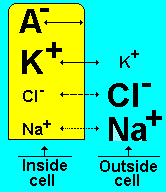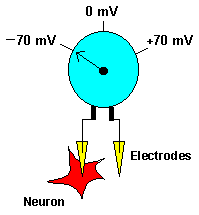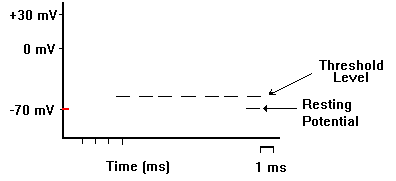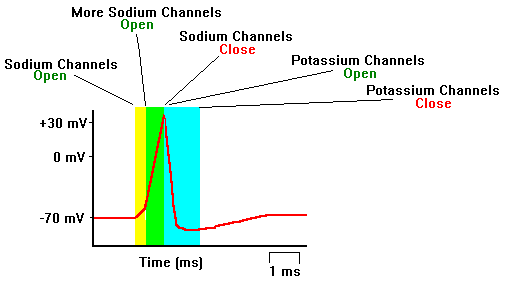Neuroscience For Kids
Lights, Camera, Action Potential
 This page describes
how neurons work. I hope this explanation does not get too complicated,
but it is important to understand how neurons do what they do. There are
many details, but go slow and look at the figures.
This page describes
how neurons work. I hope this explanation does not get too complicated,
but it is important to understand how neurons do what they do. There are
many details, but go slow and look at the figures.
 Much of what we
know about how neurons work comes from experiments on the giant axon of
the squid. This giant axon extends from the head to the tail of the squid
and is used to help the squid move. How giant is this axon? It can be
up to 1 mm in diameter - easy to see with the naked eye.
Much of what we
know about how neurons work comes from experiments on the giant axon of
the squid. This giant axon extends from the head to the tail of the squid
and is used to help the squid move. How giant is this axon? It can be
up to 1 mm in diameter - easy to see with the naked eye.
Neurons send messages electrochemically. This means that chemicals cause an electrical signal. Chemicals in the body are "electrically-charged" -- when they have an electrical charge, they are called ions. The important ions in the nervous system are sodium and potassium (both have 1 positive charge, +), calcium (has 2 positive charges, ++) and chloride (has a negative charge, -). There are also some negatively charged protein molecules. It is also important to remember that nerve cells are surrounded by a membrane that allows some ions to pass through and blocks the passage of other ions. This type of membrane is called semi-permeable.
Resting Membrane Potential
 A neuron is at rest
when it is not sending an an electrical signal. During this time, the
inside of the neuron is negative relative to the outside. Although the
concentrations of the different ions attempt to balance out on both
sides of the membrane, they cannot because the cell membrane allows only
some ions to pass through channels (ion channels). At rest, potassium
ions (K+) can cross through the membrane easily. Also at
rest, chloride ions (Cl-) and sodium ions (Na+)
have a more difficult time crossing. The negatively charged protein
molecules (A-) inside the neuron cannot cross the membrane.
A neuron is at rest
when it is not sending an an electrical signal. During this time, the
inside of the neuron is negative relative to the outside. Although the
concentrations of the different ions attempt to balance out on both
sides of the membrane, they cannot because the cell membrane allows only
some ions to pass through channels (ion channels). At rest, potassium
ions (K+) can cross through the membrane easily. Also at
rest, chloride ions (Cl-) and sodium ions (Na+)
have a more difficult time crossing. The negatively charged protein
molecules (A-) inside the neuron cannot cross the membrane.
 In addition to these selective
ion channels, there is a pump that uses energy to move
three sodium ions out of the neuron for every two potassium ions it puts
in. Finally, when all these forces balance out, and the difference in
the voltage between the inside and outside of the neuron is measured,
you have the resting potential. The resting membrane
potential of a neuron is about -70 mV (mV=millivolt) - this means that
the inside of the neuron is 70 mV less than the outside. At rest, there
are relatively more sodium ions outside the neuron and more potassium
ions inside that neuron.
In addition to these selective
ion channels, there is a pump that uses energy to move
three sodium ions out of the neuron for every two potassium ions it puts
in. Finally, when all these forces balance out, and the difference in
the voltage between the inside and outside of the neuron is measured,
you have the resting potential. The resting membrane
potential of a neuron is about -70 mV (mV=millivolt) - this means that
the inside of the neuron is 70 mV less than the outside. At rest, there
are relatively more sodium ions outside the neuron and more potassium
ions inside that neuron.
Action Potential

The resting potential tells about what happens when a neuron is at rest. An action potential occurs when a neuron sends information down an axon, away from the cell body. Neuroscientists use other words, such as a "spike" or an "impulse" for the action potential. The action potential is an explosion of electrical activity that is created by a depolarizing current. This means that some event (a stimulus) causes the resting potential to move toward 0 mV. When the depolarization reaches about -55 mV a neuron will fire an action potential. This is the threshold. If the neuron does not reach this critical threshold level, then no action potential will fire. Also, when the threshold level is reached, an action potential of a fixed sized will always fire...for any given neuron, the size of the action potential is always the same. There are no big or small action potentials in one nerve cell - all action potentials are the same size. Therefore, the neuron either does not reach the threshold or a full action potential is fired - this is the "ALL OR NONE" principle.
 Action potentials are caused
when different ions cross the neuron membrane. A stimulus first causes
sodium channels to open. Because there are many more sodium ions on the
outside, and the inside of the neuron is negative relative to the outside,
sodium ions rush into the neuron. Remember, sodium has a positive charge,
so the neuron becomes more positive and becomes depolarized. It takes
longer for potassium channels to open. When they do open, potassium
rushes out of the cell, reversing the depolarization. Also at about this
time, sodium channels start to close. This causes the action potential to
go back toward -70 mV (a repolarization). The action potential actually
goes past -70 mV (a hyperpolarization) because the potassium channels stay
open a bit too long. Gradually, the ion concentrations go back to resting
levels and the cell returns to -70 mV.
Action potentials are caused
when different ions cross the neuron membrane. A stimulus first causes
sodium channels to open. Because there are many more sodium ions on the
outside, and the inside of the neuron is negative relative to the outside,
sodium ions rush into the neuron. Remember, sodium has a positive charge,
so the neuron becomes more positive and becomes depolarized. It takes
longer for potassium channels to open. When they do open, potassium
rushes out of the cell, reversing the depolarization. Also at about this
time, sodium channels start to close. This causes the action potential to
go back toward -70 mV (a repolarization). The action potential actually
goes past -70 mV (a hyperpolarization) because the potassium channels stay
open a bit too long. Gradually, the ion concentrations go back to resting
levels and the cell returns to -70 mV.
And there you have it...the Action Potential
Try it! |
|
Did you know? |
The giant axon of the squid can be 100 to 1000 times larger than a mammalian axon. The giant axon innervates the squid's mantle muscle. These muscles are used to propel the squid through the water. |
Copyright © 1996-2020, Eric H. Chudler All Rights Reserved.
